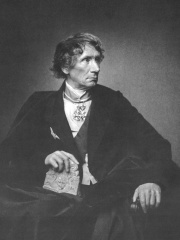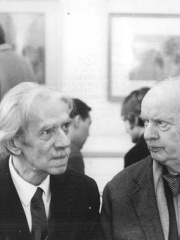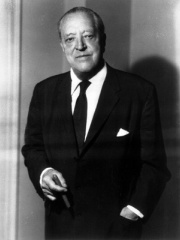
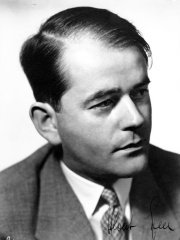
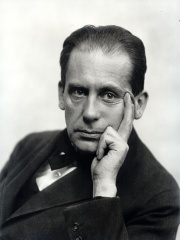
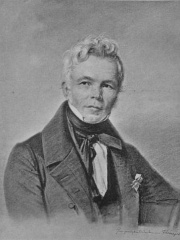
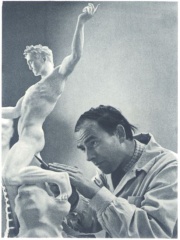
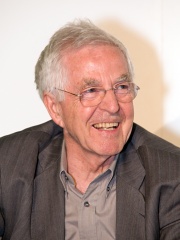
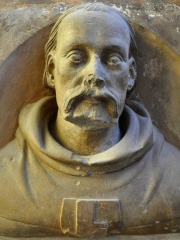
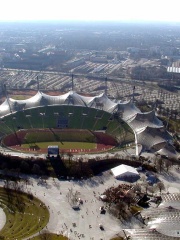
The Most Famous
ARCHITECTS from Germany
This page contains a list of the greatest German Architects. The pantheon dataset contains 518 Architects, 52 of which were born in Germany. This makes Germany the birth place of the 2nd most number of Architects.
Top 10
The following people are considered by Pantheon to be the top 10 most legendary German Architects of all time. This list of famous German Architects is sorted by HPI (Historical Popularity Index), a metric that aggregates information on a biography's online popularity. Visit the rankings page to view the entire list of German Architects.

1. Ludwig Mies van der Rohe (1886 - 1969)
With an HPI of 81.84, Ludwig Mies van der Rohe is the most famous German Architect. His biography has been translated into 74 different languages on wikipedia.
Ludwig Mies van der Rohe ( MEESS-...-ROH; German: [ˈluːtvɪç ˈmiːs fan deːɐ̯ ˈʁoːə]; born Maria Ludwig Michael Mies; March 27, 1886 – August 17, 1969) was a German and American architect, academic, and interior designer. He was commonly referred to as Mies, his surname. He is regarded as one of the pioneers of modern architecture. In the 1930s, Mies was the last director of the Bauhaus, a ground-breaking school of modernist art, design and architecture in Germany. After Nazism's rise to power, due to its strong opposition to modernism, he emigrated to the United States in 1937 or 1938. He accepted the position to head the architecture school at what is today the Illinois Institute of Technology (IIT). Mies sought to establish his own particular architectural style that could represent modern times. His buildings made use of modern materials such as industrial steel and plate glass to define interior spaces. He is often associated with his fondness for the aphorisms "less is more" and "God is in the details".

2. Albert Speer (1905 - 1981)
With an HPI of 79.89, Albert Speer is the 2nd most famous German Architect. His biography has been translated into 71 different languages.
Berthold Konrad Hermann Albert Speer (; German: [ˈʃpeːɐ̯] ; 19 March 1905 – 1 September 1981) was a German architect who served as Minister of Armaments and War Production in Nazi Germany during most of World War II. A close friend and ally of Adolf Hitler, he was convicted at the Nuremberg trials and served 20 years in prison. An architect by training, Speer joined the Nazi Party in 1931. His architectural skills made him increasingly prominent within the Party, and he became a member of Hitler's inner circle. Hitler commissioned him to design and construct structures, including the Reich Chancellery and the Nazi Party rally grounds in Nuremberg. In 1937, Hitler appointed Speer as General Building Inspector for Berlin. In this capacity he was responsible for the Central Department for Resettlement that evicted Jewish tenants from their homes in Berlin. In February 1942, Speer was appointed as Reich Minister of Armaments and War Production. Using misleading statistics, he promoted himself as having performed an armaments miracle that was widely credited with keeping Germany in the war. In 1944, Speer established a task force to increase production of fighter aircraft. It became instrumental in exploiting slave labor for the benefit of the German war effort. After the war, Speer was among the 24 "major war criminals" charged by the International Military Tribunal for Nazi atrocities. He was found guilty of war crimes and crimes against humanity, principally for the use of slave labor, narrowly avoiding a death sentence. Having served his full term, Speer was released in 1966. He used his writings from the time of imprisonment as the basis for two autobiographical books, Inside the Third Reich and Spandau: The Secret Diaries. Speer's books were a success; the public was fascinated by the inside view of the Third Reich he provided. He died of a stroke in 1981. Through his autobiographies and interviews, Speer carefully constructed an image of himself as a man who deeply regretted having failed to discover the crimes of the Third Reich. He continued to deny explicit knowledge of, and responsibility for, the Holocaust. This image dominated his historiography in the decades following the war, giving rise to the "Speer myth": the perception of him as an apolitical technocrat responsible for revolutionizing the German war machine. The myth began to fall apart in the 1980s, when the armaments miracle was attributed to Nazi propaganda. Twenty-five years after Speer's death, Adam Tooze wrote in The Wages of Destruction that the idea that Speer was an apolitical technocrat was "absurd". Martin Kitchen, writing in Speer: Hitler's Architect, stated that much of the increase in Germany's arms production was actually due to systems instituted by Speer's predecessor (Fritz Todt) and that Speer was intimately aware of and involved in the Final Solution, evidence of which has been conclusively shown in the decades following the Nuremberg trials.

3. Walter Gropius (1883 - 1969)
With an HPI of 78.26, Walter Gropius is the 3rd most famous German Architect. His biography has been translated into 79 different languages.
Walter Adolph Georg Gropius (German: [ˈvaltɐ ˈadɔlf ˈɡeːɔʁk ˈɡʁoːpiʊs]; 18 May 1883 – 5 July 1969) was a German-American architect and founder of the Bauhaus School, who is widely regarded as one of the pioneering masters of modernist architecture. He was a founder of Bauhaus in Weimar and taught there for several years, becoming known as a leading proponent of the International Style. Gropius emigrated from Germany to England in 1934 and from England to the United States in 1937, where he spent much of the rest of his life teaching at the Harvard Graduate School of Design. In the United States he worked on several projects with Marcel Breuer and with the firm The Architects Collaborative, of which he was a founding partner. In 1959, he won the AIA Gold Medal, one of the most prestigious awards in architecture.

4. Karl Friedrich Schinkel (1781 - 1841)
With an HPI of 74.55, Karl Friedrich Schinkel is the 4th most famous German Architect. His biography has been translated into 61 different languages.
Karl Friedrich Schinkel (German pronunciation: [ˈkaʁl ˈfʁiːdʁɪç ˈʃɪŋkl̩]; 13 March 1781 – 9 October 1841) was a Prussian architect, city planner and painter who also designed furniture and stage sets. Schinkel was one of the greatest German architects, a nineteenth century design genius, and a leader in the International Neoclassical and Gothic Revival movements. His most famous buildings are found in and around Berlin, where he influenced the city's design and landscape profoundly. Schinkel's Bauakademie is considered one of the forerunners of modern architecture. His Altes Museum is one of the most important classical buildings in Europe and a model for future national art museums throughout the world.
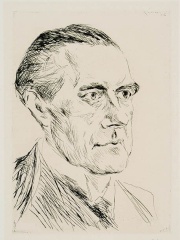
5. Peter Behrens (1868 - 1940)
With an HPI of 72.86, Peter Behrens is the 5th most famous German Architect. His biography has been translated into 50 different languages.
Peter Behrens (14 April 1868 – 27 February 1940) was a leading German architect, graphic and industrial designer, best known for his early pioneering AEG Turbine Hall in Berlin in 1909. He had a long career, designing objects, typefaces, and important buildings in a range of styles from the 1900s to the 1930s. He was a founding member of the German Werkbund in 1907, when he also began designing for AEG, pioneered corporate design, graphic design, producing typefaces, objects, and buildings for the company. In the next few years, he became a successful architect, a leader of the rationalist / classical German Reform Movement of the 1910s. After the First World War, he turned to Brick Expressionism, designing the remarkable Hoechst Administration Building outside Frankfurt, and from the mid-1920s increasingly to New Objectivity. He was also an educator, heading the architecture school at Academy of Fine Arts Vienna from 1922 to 1936. As a well known architect he produced design across Germany, in other European countries, Russia and England. Several of the leading names of European modernism worked for him when they were starting out in the 1910s, including Ludwig Mies van der Rohe, Le Corbusier and Walter Gropius.

6. Arno Breker (1900 - 1991)
With an HPI of 70.57, Arno Breker is the 6th most famous German Architect. His biography has been translated into 34 different languages.
Arno Breker (19 July 1900 – 13 February 1991) was a German sculptor who is best known for his public works in Nazi Germany, where he was endorsed by the authorities as the antithesis of degenerate art. He was made official state sculptor and exempted from military service. One of his better known statues is Die Partei, representing the spirit of the Nazi Party, which flanked one side of the carriage entrance to Albert Speer's new Reich Chancellery. After the fall of Nazi Germany in 1945 Breker continued to thrive professionally as a sculptor in the new West Germany.

7. Albert Speer (1934 - 2017)
With an HPI of 69.62, Albert Speer is the 7th most famous German Architect. His biography has been translated into 26 different languages.
Albert Speer Jr. (German pronunciation: [ˈʃpeːɐ̯]; 29 July 1934 – 15 September 2017) was a German architect and urban planner. He was the son of Albert Speer (1905–1981), Adolf Hitler's chief architect before assuming the office of Minister of Armaments and War Production for Germany during World War II. His grandfather, Albert Friedrich Speer, was also an architect.

8. Peter Parler (1330 - 1399)
With an HPI of 69.55, Peter Parler is the 8th most famous German Architect. His biography has been translated into 36 different languages.
Peter Parler (German: Peter von Gemünd, Czech: Petr Parléř, Latin: Petrus de Gemunden in Suevia; 1333 – 13 July 1399) was a German-Bohemian architect and sculptor from the Parler family of master builders. Along with his father, Heinrich Parler, he is one of the most prominent and influential craftsmen of the Middle Ages. Born and apprenticed in the town of Schwäbisch Gmünd, Peter worked at several important late Medieval building sites, including Strasbourg, Cologne, and Nuremberg. After 1356 he lived in Prague, capital of the Kingdom of Bohemia and seat of the Holy Roman Empire, where he created his most famous works: St. Vitus Cathedral and the Charles Bridge.

9. Frei Otto (1925 - 2015)
With an HPI of 68.51, Frei Otto is the 9th most famous German Architect. His biography has been translated into 47 different languages.
Frei Paul Otto (German: [fʁaɪ ˈʔɔtoː]; 31 May 1925 – 9 March 2015) was a German architect and structural engineer noted for his use of lightweight structures, in particular tensile and membrane structures, including the roof of the Olympic Stadium in Munich for the 1972 Summer Olympics. Otto won the RIBA Royal Gold Medal in 2006 and was awarded the Pritzker Architecture Prize in 2015, shortly before his death.
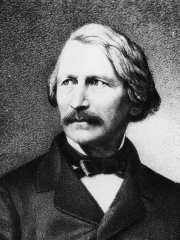
10. Gottfried Semper (1803 - 1879)
With an HPI of 68.29, Gottfried Semper is the 10th most famous German Architect. His biography has been translated into 34 different languages.
Gottfried Semper (German: [ˈɡɔtfʁiːt ˈzɛmpɐ]; 29 November 1803 – 15 May 1879) was a German architect, art critic, and professor of architecture who designed and built the Semper Opera House in Dresden between 1838 and 1841. In 1849 he took part in the May Uprising in Dresden and was put on the government's wanted list. He fled first to Zürich and later to London. He returned to Germany after the 1862 amnesty granted to the revolutionaries. Semper wrote extensively on the origins of architecture, especially in his book The Four Elements of Architecture (1851), and was one of the major figures in the controversy surrounding the polychrome architectural style of ancient Greece. He designed works at all scales—from major urban interventions such as the redesign of the Ringstraße in Vienna, to a baton for Richard Wagner. His unrealised design for an opera house in Munich was, without permission, adapted by Wagner for the Bayreuth Festspielhaus.
People
Pantheon has 52 people classified as German architects born between 1330 and 1954. Of these 52, 1 (1.92%) of them are still alive today. The most famous living German architects include Hermann Tilke. The most famous deceased German architects include Ludwig Mies van der Rohe, Albert Speer, and Walter Gropius.
Living German Architects
Go to all RankingsDeceased German Architects
Go to all RankingsLudwig Mies van der Rohe
1886 - 1969
HPI: 81.84
Albert Speer
1905 - 1981
HPI: 79.89
Walter Gropius
1883 - 1969
HPI: 78.26
Karl Friedrich Schinkel
1781 - 1841
HPI: 74.55
Peter Behrens
1868 - 1940
HPI: 72.86
Arno Breker
1900 - 1991
HPI: 70.57
Albert Speer
1934 - 2017
HPI: 69.62
Peter Parler
1330 - 1399
HPI: 69.55
Frei Otto
1925 - 2015
HPI: 68.51
Gottfried Semper
1803 - 1879
HPI: 68.29
Leo von Klenze
1784 - 1864
HPI: 66.94
Hans Scharoun
1893 - 1972
HPI: 65.32
Overlapping Lives
Which Architects were alive at the same time? This visualization shows the lifespans of the 25 most globally memorable Architects since 1700.


